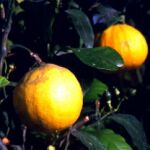| Common Name: |
Bergamot Orange |
| Botanical Name: |
Citrus bergamia |
| Family: |
Rutaceae |
| Location: |
Ivory Coast, Southern Italy, Sicily |
| Extraction: |
Expression |
| Parts Used: |
Fruit Peel |
| Color and Odor: |
The essential oil is green in color and has a light citrusy and sweet aroma with a delicate floral hint. |
| Background: |
The bergamot fruit was developed for its scent, which has been used in perfumery since the 18th Century. It was named after the city of Bergamo in the Northern Italian district of Lombardy. It has been used in Italian folk medicine for many years. Bergamot is used to flavor Earl Grey tea; the essential oil is an ingredient of Eau-de-Cologne. |
| Properties: |
Antispasmodic, carminative, antiseptic, sedative, uplifting. |
| Precaution: |
Bergamot essential oil is photoxic. Do not use before being exposed to strong UV light. |
| Direction |
East |
| Uses: |
- Digestive Sytem—Bergamot will stimulate appetite in cases of anorexia nervosa, and will also help to regulate the appetite of compulsive eaters.
- Urinary System—Strongly indicated for all urinary tract infections including cystitis and urethritis.
- Reproductive Sytem—Effective for vaginal pruritus and leucorrhoea.
- Skin—Useful in treating oily skin, boils, and acne. Also effective for coldsores
- Emotions—Bergamot's uplifting and balancing qualities are very useful for treating listlessness, depression, and anxiety. It can encourage a restful, relaxing sleep at night.
|
| Blends: |
| DIGESTIVE |
URINARY |
REPRODUCTIVE |
| Bergamot 7 |
Bergamot 7 |
Bergamot 4 |
| Anise 3 |
Juniper 4 |
Myrrh 4 |
| Ginger 2 |
Sandalwood 3 |
Chamomile (R) 3 |
|
| SKIN |
EMOTION |
| Bergamot 6 |
Bergamot 8 |
| Lavender 4 |
Cypress 3 |
| Tea tree 3 |
Lavender 2 |
| Bibliography: |
Aromatherapy Blends and recipes by Franzesca Watson Copyright © 1995 Thorsons, Harper Parker Publishing Inc. Pp 62-63 |
|

